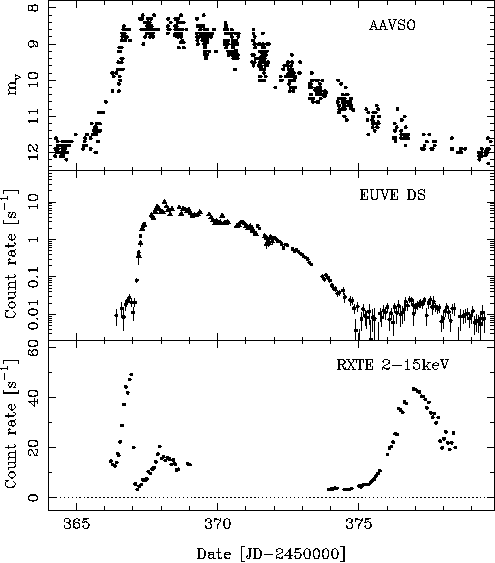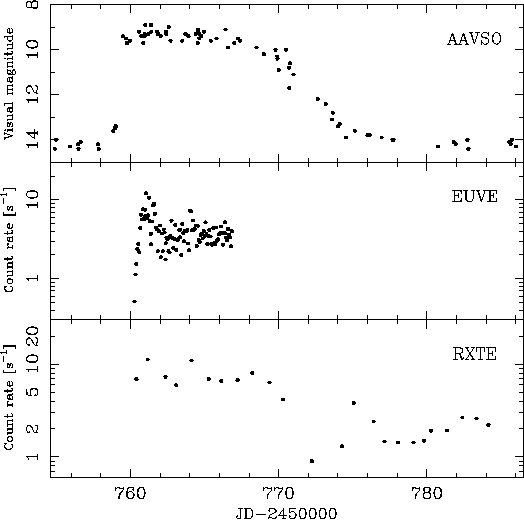In October 1996 the brightest dwarf nova in the sky - SS Cygni - went into outburst, and was observed for the next twelve days by RXTE (P.I. Peter Wheatley), EUVE (P.I. Chris Mauche), and the American Association of Variable Star Observers (AAVSO) (headed by Janet Mattei). The three light curves are shown in Figure 1. SS Cygni has historically been considered by the AAVSO to be their highest priority object because of its interesting behavior and brightness. It has been observed for over 100 years, and recently has often been the target of coordinated campaigns employing several satellites. SS Cyg has an orbital period of 6.6 hrs and goes into outburst about once every 50 days, during which time its optical flux increases by ~3.5 magnitudes. The durations of the outbursts in SS Cyg show a bimodal distribution: they last either ~7 days or ~14 days, and usually these alternate. (The Oct 1996 outburst was a short one.) The same group also had coordinated observations of the second brightest dwarf nova - U Geminorum - in November 1997. Figure 2 shows the light curves from the AAVSO, EUVE, and RXTE. U Gem is different in several important ways from SS Cyg, for instance its orbital period is only 4.4 hrs, and the plane of the orbit is nearly edge-on to our line of sight. This difference in viewing perspective could produce differences in the outbursting behavior. Note for instance that in SS Cyg the optical and X-ray fluxes were anti-correlated with each other, whereas in U Gem the two fluxes are correlated. Dwarf novae (DNe) make up a subclass of the cataclysmic variable stars - interacting binaries in which a mass losing K star transfers material to a white dwarf. Such binaries are compact in the sense that their orbital periods are typically hours; indeed a dwarf nova would fit inside our Sun. DNe are characterized by semi-periodic outbursts which were historically first seen at optical wavelengths, and in recent years have been studied increasingly at other wavelengths. The outbursts are thought to be caused by the operation of a limit cycle mechanism within the ``accretion disk'' of matter about the white dwarf. On a time scale which ranges from days to decades, matter is accumulated in the accretion disk in a quiescent phase, and then accreted onto the white dwarf during an outburst phase. The increased release of gravitational potential energy accompanying the burst of accretion is thought to power the outbursts. The following two movies show the evolution of surface density and brightness temperature over 65 days in a numerical model of a dwarf nova accretion disk. The mass of the white dwarf accretor is 0.7 solar mass, the outer accretion disk radius is 230,000 km, and the rate at which material is being added at the outer edge of the disk is 2.1 X 10^16 grams per second. The movies span two outbursts, a ``short'' one and a ``long'' one. For the short outburst, the heating front which takes the disk from the low state to the high state does not propagate all the way to the outer disk edge, whereas for the long outburst the heating front does reach the outer edge. movie3.mov . movie4.mov . Although this general model is accepted, there are details involving the boundary layer and the production of EUV and X-ray flux which are not understood.
Figure 1: Light Curve in Three Wavelengths of Outburst in SS Cyg.
Figure 2: Light Curve in Three Wavelengths of Outburst in U Gem.
Figures provided by Peter Wheatley. Movies, captions, and supporting text provided by J. Cannizzo Back to Snazzy Science If you have a question about RXTE, please send email to one of our help desks.
|




